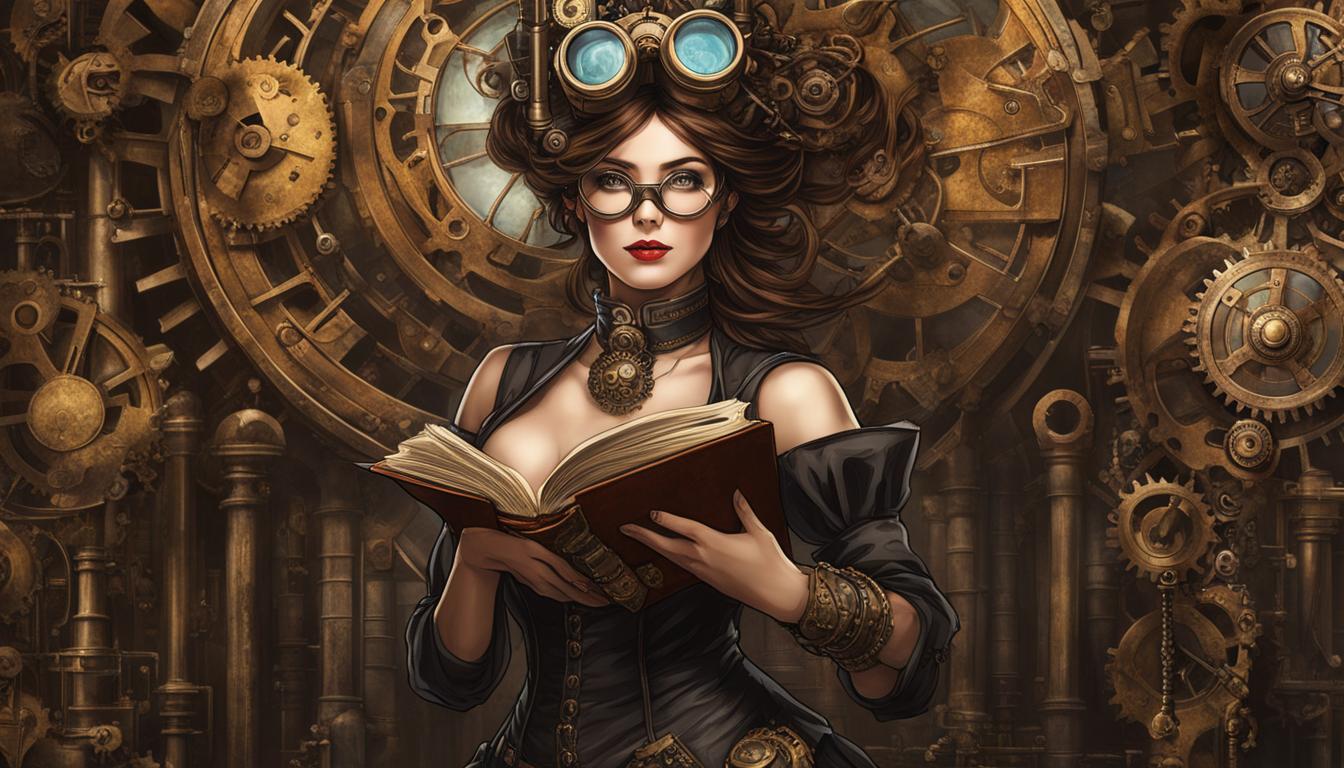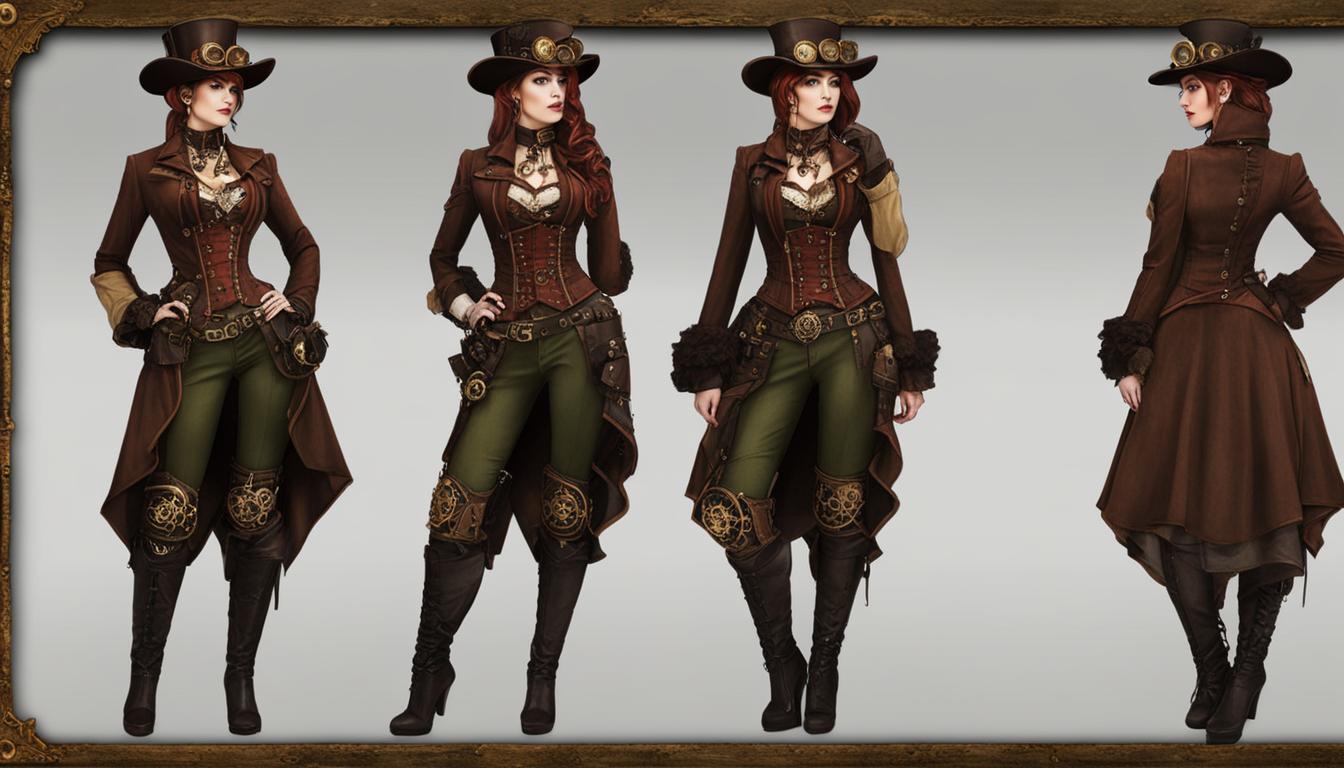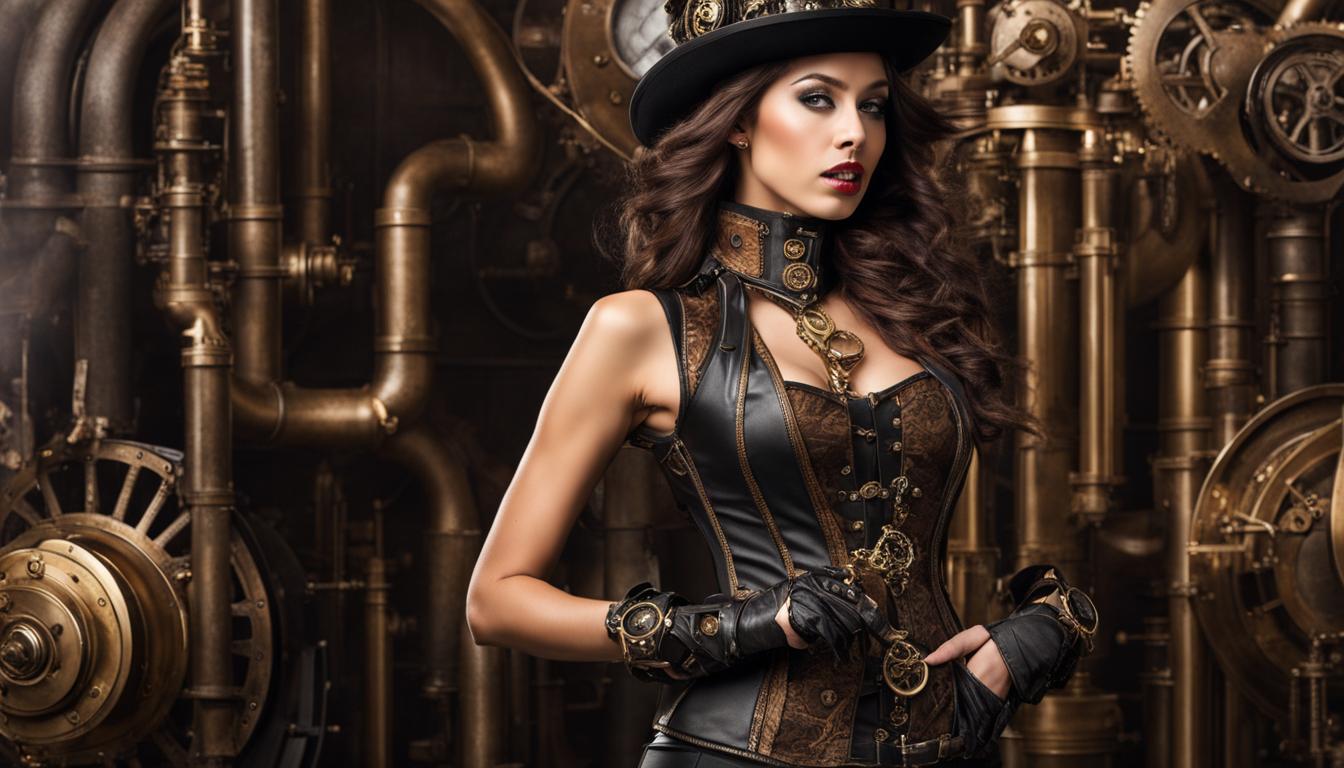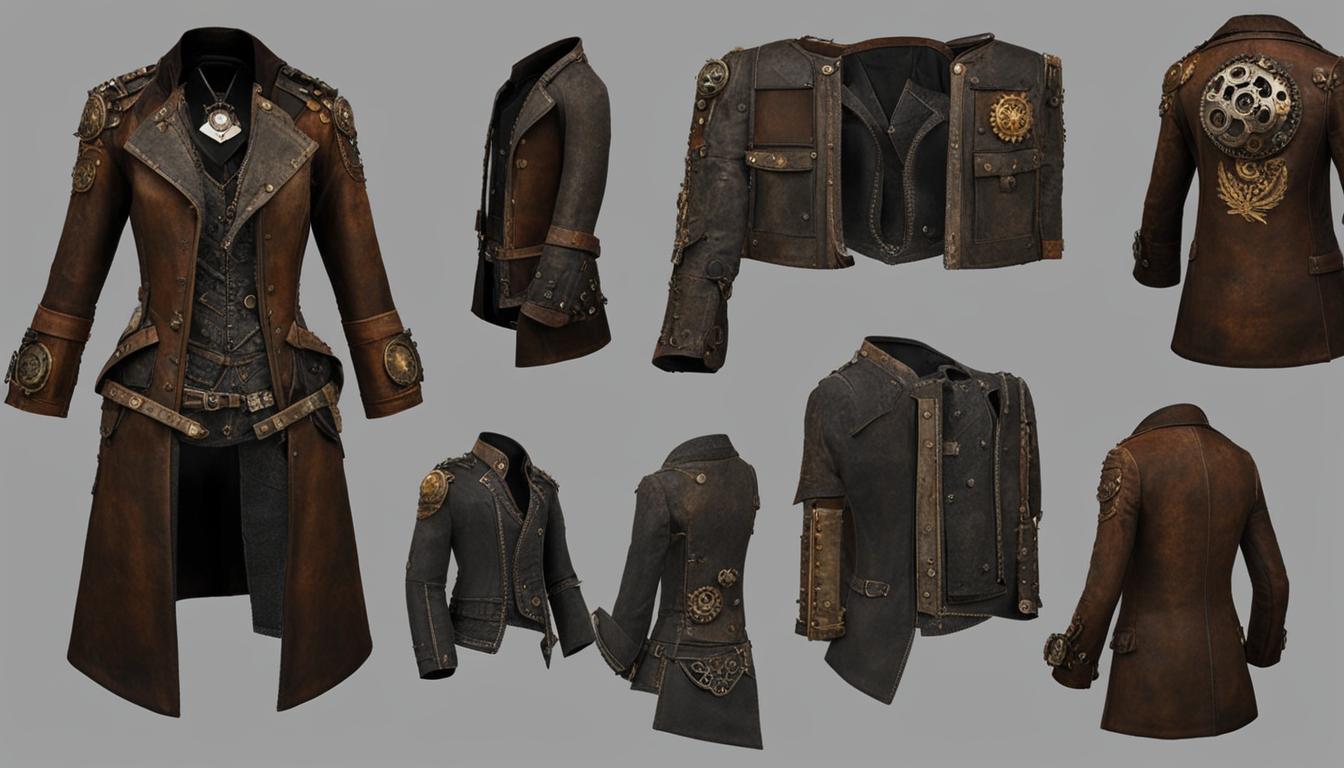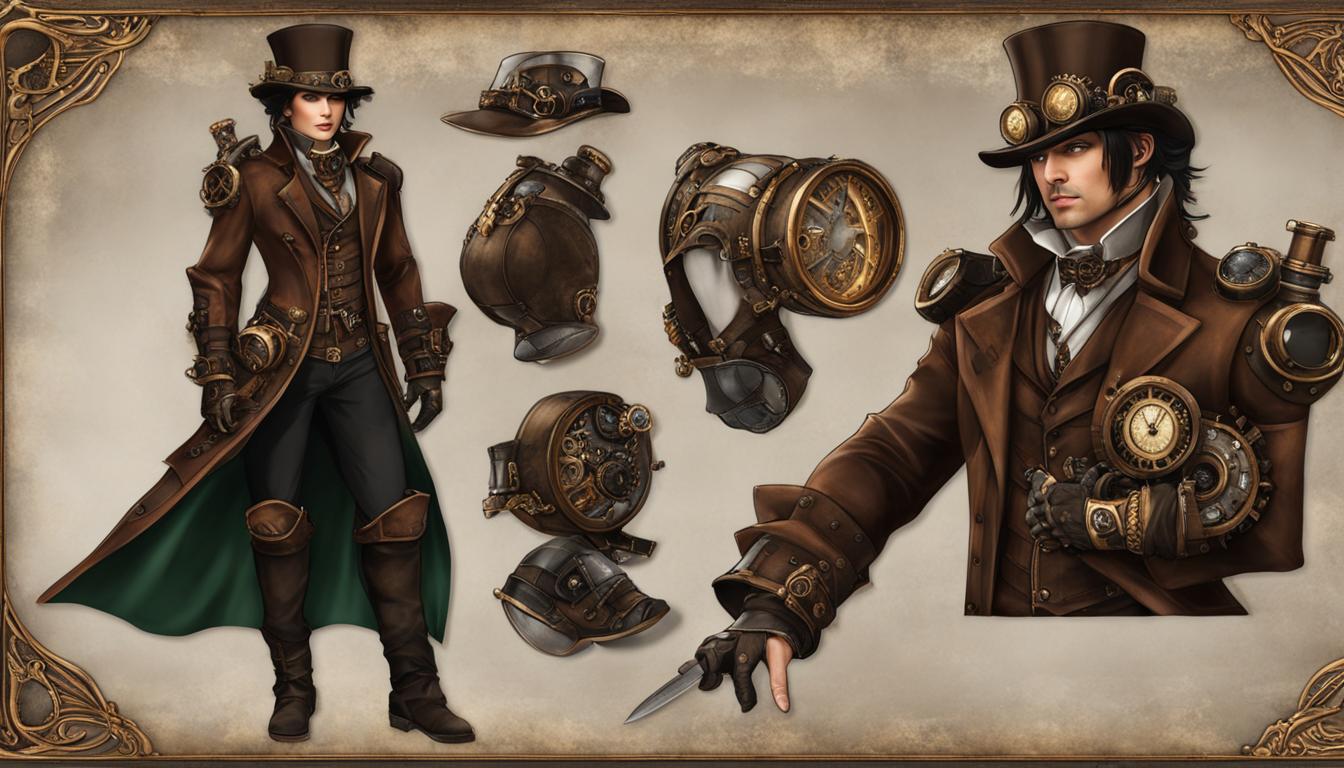Step into the retro-futuristic world of steampunk fashion, where Victorian elegance meets mechanical marvels. This unique style is not only influenced by art, film, and music, but also by the captivating narratives found within the pages of literature. From classic novels to steampunk adaptations of beloved characters, the literary world provides a rich tapestry of inspiration for those seeking to create their own steampunk look.
Steampunk fashion captures the essence of the Victorian era, combining elements from that time with a dash of imagination and a pinch of technological advancements. It’s a style that embraces corsets, top hats, goggles, gears, and other mechanical accessories, all brought together in a retro-futuristic fusion.
So, how can literature ignite the spark of steampunk fashion inspiration? Let’s explore the intriguing ways in which the written word unlocks a realm of creativity and fashion possibilities.
Key Takeaways:
- Literature serves as a wellspring of inspiration for steampunk fashion, offering themes, aesthetics, and ideas to fuel creativity.
- Classic novels like “The Difference Engine,” “20,000 Leagues Under the Sea,” and “The Golden Compass” have significantly influenced the steampunk aesthetic.
- Steampunk enthusiasts often reimagine well-known literary characters, transforming them into steampunk fashion icons.
- Novels with steampunk elements provide detailed descriptions of clothing and accessories, inspiring readers to recreate the fashion in their own outfits.
- Steampunk fashion draws heavily from the Victorian era, incorporating elements such as bustle skirts, corsets, top hats, and lace.
Steampunk Fashion in Classic Novels
Classic novels have played a significant role in influencing steampunk fashion. Books like “The Difference Engine” by Bruce Sterling and William Gibson, “20,000 Leagues Under the Sea” by Jules Verne, and “The Golden Compass” by Phillip Pullman have introduced readers to the steampunk aesthetic and inspired them to incorporate elements of Victorian clothing and technology into their outfits. These novels have served as a source of literary steampunk inspiration and have paved the way for the popularity of steampunk fashion.
In “The Difference Engine,” set in an alternate Victorian era, the authors combine historical events with steampunk elements, showcasing characters dressed in Victorian clothing adorned with mechanical gadgets and accessories. This blend of history and fiction has captivated readers, inspiring them to recreate these looks in their own steampunk outfits.
Jules Verne’s “20,000 Leagues Under the Sea” takes readers on an underwater adventure with Captain Nemo, who sports a distinctive steampunk-inspired outfit. His attire features a combination of Victorian formal wear and futuristic gadgets, such as diving suits with built-in technologies. This novel has become an iconic reference for steampunk enthusiasts looking to incorporate nautical elements into their fashion choices.
Phillip Pullman’s “The Golden Compass,” part of the “His Dark Materials” trilogy, introduces readers to a world filled with airships, armored bears, and a blend of Victorian and steampunk-inspired fashion. The protagonist, Lyra, wears a mix of Victorian clothing and practical steampunk accessories as she embarks on her extraordinary adventures. This novel has inspired readers to explore the possibilities of adapting their favorite literary characters into a steampunk fashion context.
| Novel | Author | Steampunk Elements |
|---|---|---|
| The Difference Engine | Bruce Sterling, William Gibson | Victorian clothing with mechanical gadgets and accessories |
| 20,000 Leagues Under the Sea | Jules Verne | Nautical steampunk fashion with futuristic diving suits |
| The Golden Compass | Phillip Pullman | Victorian clothing mixed with steampunk accessories |
Steampunk Adaptations of Literary Characters
Steampunk fashion enthusiasts have embraced the creativity of reimagining well-known literary characters in steampunk style. By infusing Victorian-inspired clothing, accessories, and technological gadgets, these adaptations bring a unique twist to beloved characters from classic literature. From the brilliant detective Sherlock Holmes to the whimsical Alice in Wonderland and the enigmatic Captain Nemo from “20,000 Leagues Under the Sea,” steampunk adaptations offer endless possibilities for character costume ideas.
“The steampunk adaptation of literary characters allows fans to explore the intersection of fashion, literature, and imagination. It’s a way to pay homage to beloved stories while adding a dash of retro-futuristic flair,” says renowned steampunk fashion designer, Elizabeth Crimson.
Steampunk adaptations of literary characters often combine the essence of the original character with the aesthetics and themes of the steampunk genre. For example, a steampunk Sherlock Holmes may sport a modified deerstalker hat adorned with gears and goggles, while Alice in Wonderland might don a corseted dress with clockwork-inspired accessories. These adaptations not only demonstrate the versatility of steampunk fashion but also celebrate the enduring influence of literature in shaping our creative expressions.
So, whether you’re attending a steampunk convention, cosplay event, or simply looking to infuse your everyday style with literary steampunk inspiration, exploring steampunk adaptations of literary characters can ignite your imagination and unlock a world of fashion possibilities.
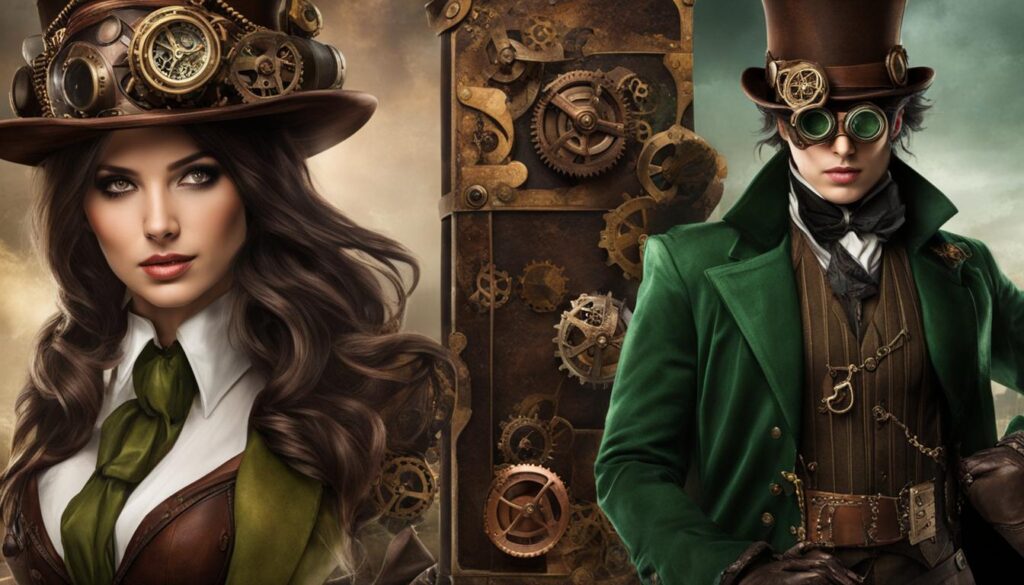
Table: Steampunk Adaptations of Literary Characters
| Character | Literary Source | Steampunk Adaptation |
|---|---|---|
| Sherlock Holmes | Sir Arthur Conan Doyle’s “Sherlock Holmes” series | Modified deerstalker hat, goggles, gears, and a retro-futuristic trench coat |
| Alice | Lewis Carroll’s “Alice’s Adventures in Wonderland” | Corseted dress, clockwork-inspired accessories, and a top hat with playing card embellishments |
| Captain Nemo | Jules Verne’s “20,000 Leagues Under the Sea” | Vintage diving suit, mechanical arm enhancements, and a futuristic submarine-inspired insignia |
| Dr. Jekyll and Mr. Hyde | Robert Louis Stevenson’s “Strange Case of Dr. Jekyll and Mr. Hyde” | A split personality ensemble featuring a tailored Victorian suit with steampunk accents representing the duality of the character |
| Miss Havisham | Charles Dickens’ “Great Expectations” | Tattered, layered wedding dress, accessorized with cobwebs, skeleton keys, and a timepiece frozen at the moment of betrayal |
Steampunk Fashion Elements in Novels with Steampunk Elements
Steampunk fashion has not only become popular within the subculture but has also found its way into the pages of novels. Authors like Gail Carriger, Cherie Priest, and Scott Westerfeld have created fictional worlds that incorporate steampunk elements, including detailed descriptions of steampunk-inspired fashion. These novels provide a rich source of inspiration for those looking to infuse their own wardrobe with a touch of literary steampunk.
In Gail Carriger’s “Parasol Protectorate” series, readers are transported to a Victorian London where supernatural beings and steampunk inventions coexist. Carriger vividly describes intricate bustle gowns, corsets adorned with gears and clockwork accessories, and fashionable parasols with hidden gadgets. The combination of Victorian elegance and the mechanical elements of steampunk creates a visually captivating aesthetic.
“The outfit consisted of a bustle gown with an exaggerated ruffled skirt, paired with a corset adorned with gears, and a matching top hat with a clockwork fascinator. The finishing touch was a pair of lace-up boots with brass buckles and mechanical wings that fluttered with each step.”
Cherie Priest’s “The Clockwork Century” series takes readers on a thrilling adventure through a post-Civil War America filled with airships, zombies, and steam-powered technology. The characters in her novels are often dressed in rugged yet stylish attire, with leather overcoats, goggles, and utility belts. Priest’s descriptions provide a vivid portrayal of the practical yet fashionable nature of steampunk fashion.
Scott Westerfeld’s “Leviathan” trilogy offers a unique blend of steampunk and alternate history, set in a world where genetically engineered creatures and mechanical contraptions are at the center of the story. The characters in Westerfeld’s novels wear uniforms that combine elements of Victorian military attire with futuristic features, such as sky blue uniforms with brass buttons and goggles that double as night vision lenses.
These novels not only entertain readers with their captivating stories but also serve as a treasure trove of inspiration for steampunk fashion enthusiasts. From the intricate details of garments to the imaginative accessories, these novels bring the world of steampunk fashion to life and allow readers to immerse themselves in a retro-futuristic aesthetic.
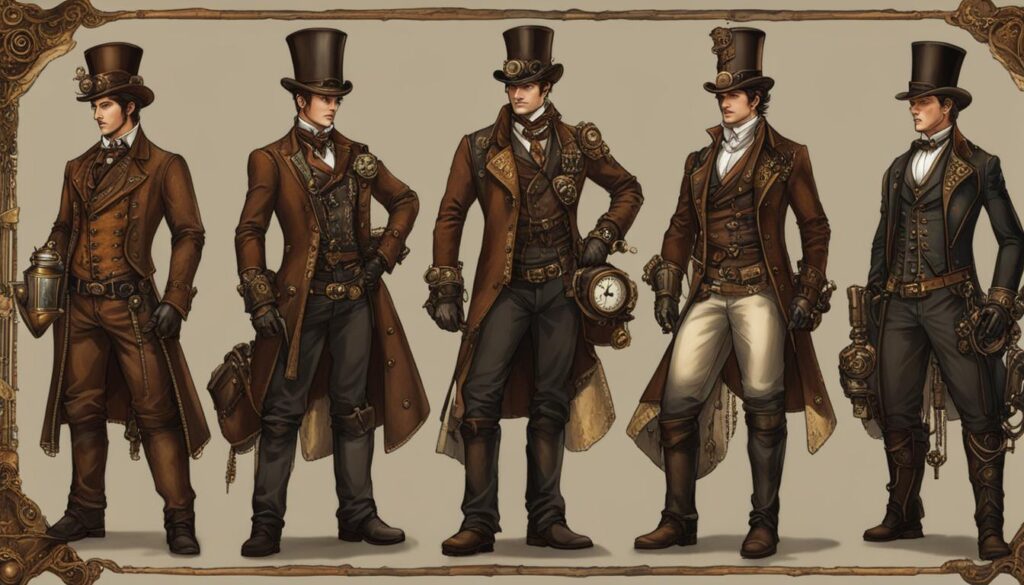
| Novel | Author | Steampunk Fashion Elements |
|---|---|---|
| Parasol Protectorate series | Gail Carriger | Bustle gowns, corsets with gears, clockwork accessories, mechanical parasols |
| The Clockwork Century series | Cherie Priest | Leather overcoats, goggles, utility belts |
| Leviathan trilogy | Scott Westerfeld | Victorian military uniforms, futuristic features, brass buttons, goggles |
Steampunk Fashion and the Victorian Era
When it comes to steampunk fashion, one cannot ignore the strong influence of the Victorian era. This retro-futuristic style draws heavily from the aesthetics of the 19th-century, combining elements of Victorian clothing with imaginative, technological twists. Steampunk fashion enthusiasts often embrace Victorian fashion staples such as bustle skirts, corsets, lace, and top hats, infusing them with the spirit of innovation and adventure that defines the steampunk genre.
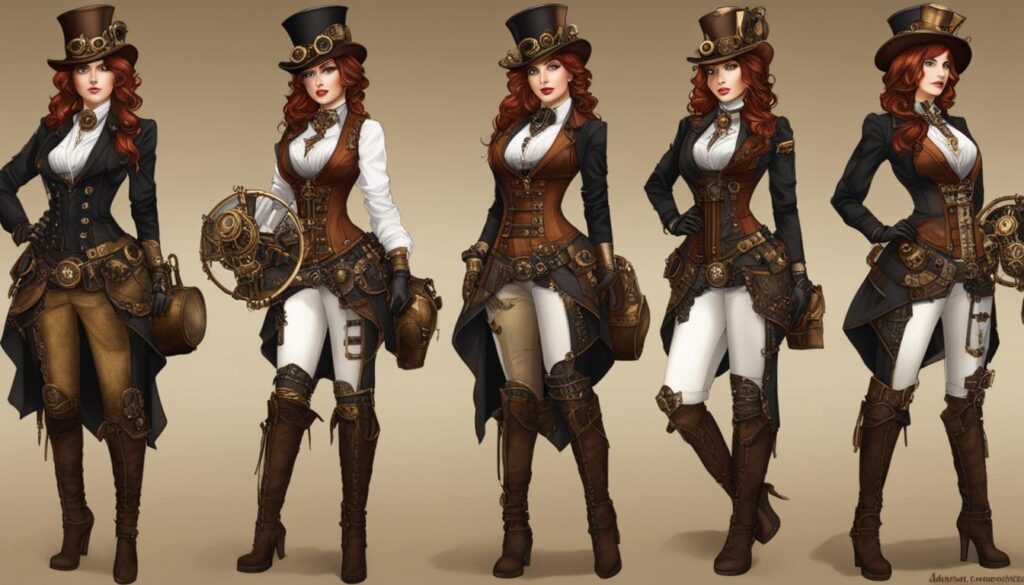
Steampunk fashion in literature often explores the themes and narratives of the Victorian era, further inspiring the fashion choices within the steampunk community. From the bustling streets of London to the mysterious depths of underground laboratories, steampunk narratives provide a rich backdrop for fashion inspiration. Authors skillfully weave together the elegance of Victorian fashion with the grit and ingenuity of the Industrial Revolution, creating a world that is both familiar and fantastical.
Just as the Victorians marveled at the technological advancements of their time, so too does the steampunk fashion of today combine elements of machinery and gadgetry. Gears, cogs, and mechanical accessories are often incorporated into steampunk outfits, adding a touch of whimsy and scientific flair. The juxtaposition of ornate lace and metal machinery exemplifies the unique and intriguing nature of steampunk fashion, capturing the imagination of both creators and admirers.
By drawing inspiration from the Victorian era, steampunk fashion embraces a bygone era while embracing the possibilities of the future. It allows individuals to express their creativity and love for literature by embodying characters and themes from beloved works of fiction. Whether it’s through the adaptation of literary characters or the detailed descriptions found in steampunk novels, the fusion of steampunk and the Victorian era continues to captivate and inspire fashion enthusiasts around the world.
Conclusion
The world of steampunk fashion is a captivating fusion of Victorian elegance and futuristic innovation. It draws inspiration from literature, where classic novels have played a significant role in shaping this unique style. From the pages of “The Difference Engine” to the depths of “20,000 Leagues Under the Sea,” these literary works have sparked the imaginations of fashion enthusiasts and prompted them to incorporate elements of steampunk into their attire.
Not only do these novels serve as a wellspring of literary steampunk inspiration, but they also offer a canvas for the adaptation of beloved characters. Sherlock Holmes takes on a new dimension with his mechanical gadgets and ornate attire, while Alice in Wonderland embarks on whimsical adventures in a world of gears and clockwork. These steampunk adaptations bring a fresh perspective to familiar figures, presenting fashion enthusiasts with endless possibilities to explore.
Steampunk fashion doesn’t stop at the written word, as there are novels that fully embrace the aesthetic and incorporate it into their rich narratives. Authors like Gail Carriger, Cherie Priest, and Scott Westerfeld have crafted worlds where steampunk fashion flourishes, offering detailed descriptions of clothing, accessories, and the overall allure of this retro-futuristic style. These novels not only entertain readers but also provide a wellspring of creative ideas for those looking to bring their own steampunk outfits to life.
At its core, steampunk fashion reconnects with the elegance and ingenuity of the Victorian era. It blends the opulence of bustle skirts and corsets with the intrigue of top hats and lace, while drawing inspiration from the Industrial Revolution and its technological marvels. Through literature, steampunk fashion explores the themes and narratives of this bygone era, allowing enthusiasts to immerse themselves in a world where past and future intertwine.
FAQ
What is steampunk fashion?
Steampunk fashion is defined as fashion inspired by the aesthetics, themes, and styles of the steampunk trend. It combines Victorian era clothing with rich and textured fabrics, accessories, and an embodiment of a retro-futuristic past.
What inspires steampunk fashion in literature?
Classic novels, such as “The Difference Engine” by Bruce Sterling and William Gibson, “20,000 Leagues Under the Sea” by Jules Verne, and “The Golden Compass” by Phillip Pullman, have introduced readers to the steampunk aesthetic and inspired them to incorporate elements of Victorian clothing and technology into their outfits.
Can I dress up as my favorite literary character in steampunk fashion?
Absolutely! Steampunk fashion enthusiasts often create steampunk adaptations of well-known literary characters, such as Sherlock Holmes, Alice in Wonderland, and Captain Nemo from “20,000 Leagues Under the Sea”. This allows for a unique and creative way to incorporate literary steampunk inspiration into fashion.
Do novels with steampunk elements describe steampunk fashion?
Yes! Authors like Gail Carriger, Cherie Priest, and Scott Westerfeld have created fictional worlds where steampunk fashion is prevalent. These novels provide detailed descriptions of clothing, accessories, and the overall aesthetic of steampunk fashion, serving as a great source of inspiration for those looking to create their own steampunk outfits based on literary references.
What elements of fashion are inspired by the Victorian era in steampunk fashion?
Steampunk fashion draws heavily from the Victorian era, incorporating elements such as bustle skirts, corsets, top hats, and lace. This blending of Victorian aesthetics with retro-futuristic elements creates a unique and intriguing fashion style.
How does steampunk fashion relate to the themes of the Victorian era?
Steampunk fashion in literature often explores the themes and narratives of the Victorian era, providing further inspiration for the fashion choices within the steampunk community.

